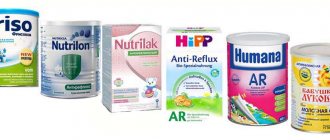Breastfeeding is the best nutrition option for a newborn. However, this is not always possible for various reasons. When artificial or mixed feeding, many mothers choose goat milk formulas for their children. The reason for the increasing popularity of such products is that goat's milk is well tolerated by babies, is easily digested and helps improve digestion, which is so important for babies.
Goat milk mixture "Nanny"
“Nanny” is a New Zealand brand of baby food, available in 4 versions: from birth, from birth with prebiotics (inulin and oligofructose), from six months with prebiotics, for children from one year.
The main advantage: the product is made from whole goat milk powder. They contain predominantly casein protein (80% casein, 20% whey). Other suppliers make whey blends (40% casein, 60% whey).
Thus, the food, according to the manufacturer, contains much more useful substances than whey mixtures. The milk in these mixtures undergoes fewer processing steps and is not diluted with whey, which is why it is more valuable in composition.
Milk fat is replaced here by sea fish oil, which is unusually rich in vitamins and minerals.
Because Nanny formulas contain less whey than other formulas, they are the tastiest formulas available that do not contain cow's milk.
Parents note that when consuming this mixture, the symptoms of an allergy to cow protein disappear in children, as well as colic common to infants, and stool normalizes.
Comparison of the best products
The table below summarizes the main characteristics of the dry mixtures that took part in today's review.
| Model | Whey content, % | Active Ingredients | Not included | Manufacturer country | Price, rub |
| "Kabrita" | 63 | bifidobacteria, prebiotics, probiotics, goat milk | sugar, preservatives, cow protein | Netherlands | 1949-3460 |
| “Nanny 1” | 20 | prebiotics, goat milk | sugar, palm oil, preservatives, starch | New Zealand | 2389-2885 |
| “MAMAKO” | 60 | bifidobacteria, prebiotics, probiotics, goat milk | artificial flavors, sugar, palm oil, preservatives, starch, gluten, artificial colors, eggs | Spain | 2210-2902 |
| “MD mil” | 60 | prebiotics, goat milk | sugar, preservatives, starch | Spain | 1250-1599 |
| “GOATTINY 1” | 52 | prebiotics, goat milk, whey proteins | palm oil, cow's milk | Czech | 765-810 (for 400 g) |
Goat milk mixture “MD Mil Kozochka”
Just like Mamako mixtures, MD Mil Kozochka baby food is presented on our market in three varieties: from birth to six months, from six months to one year, and for children over one year. The manufacturing company's offices and laboratories are located in Spain and Switzerland.
The ratio of casein and whey in these mixtures is 40/60, which is as close as possible to the proportions of the same components in woman's milk.
The main advantage: this food is the only one of all goat milk mixtures that is optimally saturated with proteins and salts. All other mixtures have a high content of these components, which can adversely affect the functioning of the intestines and kidneys of the newborn.
These mixtures contain almost the same amount of omega acids as in breast milk.
According to parents, they have a pleasant sweetish taste and rarely cause allergies. When feeding this mixture, children's stool returns to normal.
Advantages and disadvantages
There are many advantages of using a mixture based on goat milk:
- In composition and properties, the product is closer to breast milk, therefore it is absorbed quickly and completely. Curdling in the baby's immature stomach, goat protein forms an easily digestible clot that does not cause irritation to the mucous membrane.
- Among the components there are no dangerous allergenic proteins that provoke the development of atopic dermatitis.
- A minimum number of processing steps turns the mixture into an adapted food product.
- Casein is the best prevention of digestive problems, intestinal disorders and allergic reactions.
- Goat's milk contains less fat than cow's milk, so the infant's fragile gastrointestinal tract is able to cope with the absorption of the mixture.
But there are also disadvantages:
- In terms of protein type, goat milk, like cow milk, is a casein product. Maternal - to albumin, therefore it is considered the most optimal food for infants. A common misconception is that there are no allergies to goat milk formula, and this is partly true. If a child’s gastrointestinal tract reacts sharply to casein, no adapted composition will help.
- High cost compared to cow's milk based products.
Important! It is strictly forbidden to give goat's milk to a baby instead of formula! Despite the beneficial composition and valuable ingredients, the pure product will most likely cause allergies. You should not listen to the advice of the older generation and conduct dangerous experiments on your own child. Whole milk is not suitable for children under one year of age - it is simply used as a basis in the process of creating an adapted formula.
Goat milk mixture "Cabrita"
Infant formula "Kabrita" (Kabrita Gold) is available in three varieties: for children from birth to six months, from six months to one year and over one year. Food is supplied to Russia from the Netherlands.
The ratio of casein protein to whey is 40/60, which is as close as possible to the same indicator in breast milk.
The main advantage: all fats in the diet are replaced by a complex developed by. The Digest X group of fats is close to the fats contained in human breast milk and is aimed primarily at increasing the absorption of calcium by the child’s body, as well as normalizing intestinal function in infants.
These mixtures best match the price/quality ratio and are very popular on the Russian market.
Lactose deficiency in a newborn
If your baby has intestinal problems, constipation, bloating and frequent belching, your pediatrician may diagnose you with lactose intolerance. Then you will have to undergo a course of treatment and switch to special mixtures.
Important! If a child is lactose intolerant, you cannot switch to low-lactose or lactose-free formulas on your own. This requires a clear prescription from a doctor, since these mixtures are medicinal.
After eliminating the problem and improving test results, you can return to your usual diet.
Goat milk mixture "Mamako"
MAMAKO® Premium is produced in Spain and is available in three varieties: from birth to six months, from six months to one year and for children over one year.
Casein and whey in a mixture of 40/60, which brings it as close as possible to this indicator in breast milk.
MAMAKO® Premium is the only goat milk mixture that contains the IQ complex with lutein and fatty acids, for the proper formation of vision and brain, improve memory, motor skills, and thinking.
Main advantage: Absence of palm and rapeseed oils in the mixtures. And the introduction of goat milk milk fat ensures comfortable digestion for the baby and reduces the risk of constipation.
The mixture also contains prebiotics (galactooligosaccharides) and probiotics (bifidobacteria B.lactis), the combined presence of which reduces the risk of developing allergies, increases immunity and improves microflora in the intestines.
According to parents, these mixtures have a sweet taste due to the large amount of lactose.
The best formula for a newborn baby is the one that suits him
Kabrita, for example, is based on natural goat milk from family farms in the Netherlands. It is obtained from 55 farms operating according to uniform quality standards. The company pays special attention to the conditions for breeding and keeping animals. In addition, Kabrita is very scrupulous in the selection of animal feed. On farms, goats are fed an expensive delicacy - a mixture of freshly cut grass, hay with fruit, corn, carrot and potato cakes. Thanks to this diet, goats produce nutritious milk with a soft, creamy taste and delicate aroma. It makes delicious sweet mixtures for children.
Farmers from the Netherlands prefer to keep a specific breed of goat - the white dairy Saanen goat.
Their milk is known throughout the world for its taste and high nutritional value. The diet of goats is designed in such a way that one individual produces approximately 3.5 liters of milk per day. Experts emphasize that higher milk yields reduce the nutritional value and taste of milk.
The Kabrita mixture is an adapted mixture: whey proteins are added to it. The benefits of goat's milk are enhanced by the addition of the unique DigestX fat complex to the diet. It softens digestion and improves calcium absorption.
Before purchasing food for your baby, consult your child’s treating pediatrician.
- share with your friends!
Experts: Yulia Vadimovna Popkova
Nestle Nestogen 1 Infant Formula: Review
Components - 2.1
Nestogen 1 formula contains a standard set of vitamins, minerals and trace elements, but does not contain several key components. We carried out a series of tests to check whether the composition of the Nestogen 1 mixture corresponds to what is indicated on the packaging. Our studies have shown that she has minor deviations in the amount of minerals and vitamins.
Deviations from the manufacturer's statements were found in the composition of baby food: potassium (+7%), calcium (-5%) and iron (-8%). The most significant deviation among those detected was recorded in the amount of vitamin C (-11%). Considering that the daily vitamin C intake of a child under 6 months of age should exceed 30 mg/day, the manufacturer meets this requirement. Despite minor deviations, the composition corresponds to the biological norm. The measured amounts of ash almost completely correspond to the manufacturer’s statement: out of 2%, the composition contains 1.96%. In terms of the absolute amount of minerals, the Nestle Nestogen 1 mixture is at an average level. According to experts at Product-test.ru, the ideal ratio of calcium to phosphorus is close to 2:1; in Nestogen 1 it is 1.77:1, which is within the normal range.
It also contains:
- Whey proteins are easily digestible proteins for infants, unlike casein (heavy protein) in cow's milk.
- Prebiotics are oligosaccharides that are not prone to breakdown in the gastrointestinal tract and serve as food for beneficial microorganisms in the lower intestine. Helps normalize intestinal motility and promote digestion.
A very large amount of maltodextrin was found in the composition (30% of the total amount of carbohydrates). Maltodextrin is a molasses that has a sweetish taste (from 0.1 to 0.25 of the sweetness of sucrose), it is intended to increase the period of satiety of the child and the sweetness of the product. This amount of maltodextrin, according to our experts, is undesirable.
However, the mixture does not contain:
- Probiotics are live beneficial bacteria that are activated as they enter the intestines. Helps normalize digestion. Probiotics together with prebiotics normalize intestinal function.
- Nucleotides are participants in many biochemical and energetic processes in the human body.
- DHA and ARA are polyunsaturated fatty acids that are beneficial for the development of a child's brain and vision.
Security - 5.0
Nestle Nestogen 1 is safe - experts from Product-test.ru came to this conclusion. There are no toxins or pathogenic microorganisms in it, and no sucrose was detected either. The sweetness of the milk mixture is determined by the addition of maltodextrin.
Taste and quality of breeding
The Nestozhen 1 mixture, according to reviews from our tasters, has an excessively sweet taste and aftertaste. They rated its taste as “satisfactory.” It is worth noting that an excessively sweet mixture can lead not only to tooth decay, but also make your baby picky about food, for example, to bland food.
Nestle Nestogen 1 dissolves very quickly in water, as do mixtures of the Enfamil and Similaс brands.
The manufacturer suggests maintaining a ratio of 1:6.7 when dissolving the mixture. For every gram of mixture there should be 6.7 ml of water boiled and cooled to 35-40 degrees. From the point of view of our experts, this is quite prudent, given that the mixture swells quickly from moisture. Remember, if you dilute it at elevated temperatures, then vitamins are lost in it.
Packaging and ease of breeding
Nestogen 1 milk formula is sold in 350 gram cartons. The packaging is not intended for long-term storage of the mixture (the open package can be closed hermetically only with a clothespin); the manufacturer recommends using the product within 3 weeks, which, by the way, is quite realistic: a baby up to 6 months may need about 100 grams of the mixture per day. The bag cannot have a dosing scraper, so you will have to remove the slide from the spoon with something flat.
The dosing spoon for the mixture is convenient and almost precise. Manufacturer Nestozhen 1 indicates that one spoon without a slide is equal to 4.47 grams. Our tests showed that a level spoon holds 4.3 to 4.8 grams of mixture. Although the average deviation cannot be called large, you should still check the mass of the mixture and water on a kitchen scale - it will be more reliable.










